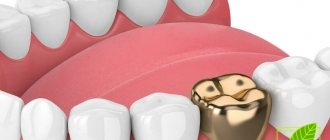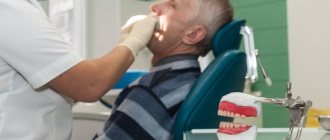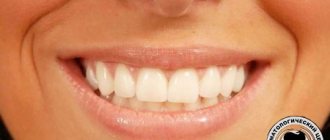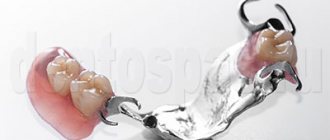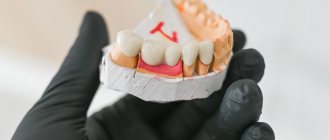What is dental implantation When do you need an alternative How can you replace implants For chewing teeth For front teeth With complete edentia Why do you need to restore teeth Which method is better
Patients are looking for an alternative to implantation due to financial or clinical restrictions on the implantation of artificial roots. Removable dentures (clasp, flexible, acrylic) and fixed products made of metal ceramics, all-ceramic, zirconium (dental bridges) can not fully replace implants. Rarely, missing units are replaced by displacing adjacent ones using braces. The preferred option is implantation: it guarantees an aesthetic, long-term and reliable result, with safety for neighboring units and benefits for the jawbone.
When an alternative to dental implants may be needed
Not everyone can get implantation. Contraindications for surgery:
- mental pathologies;
- immunodeficiency states;
- cancer;
- decompensated diabetes mellitus;
- rheumatism;
- problems with blood clotting;
- diseases of the central nervous system;
- diseases of bone tissue;
- inflammatory processes;
- severe heart pathologies;
- renal failure;
- increased sensitivity to antiseptics;
- age up to 18 years.
The list of contraindications varies depending on the implantation method. In addition to the restrictions on installing titanium roots, implantation has other disadvantages:
- relatively high cost of treatment;
- risk of implant rejection;
- the likelihood of damage to the maxillary sinuses (with prosthetics in the upper jaw row);
- complexity of the operation (the integrity of soft, bone tissue, nerve endings and mucous membranes is damaged - postoperative swelling and pain occur).
Buy a discount coupon
Many dental clinics post their coupons online, and you will need to pay an annual or monthly fee to qualify for discounted services. For example, you pay a set amount per year and receive a two-time examination or dental treatment with a discount on certain types of services. The discount can vary from 10 to 60% of the total cost of the service provided. This can be quite beneficial, and if you purchase a membership to a small community of dentists, you can save even more.
What can replace dental implantation?
Removable dentures
If the patient does not have money for implants, they make do with removable dentures, which can be inserted and removed from the mouth without the help of a dentist. The type of structure being installed determines the number of lost units:
- there are not several units in a row - partial structures are needed;
- If you need to replace your teeth, a full removable structure will help out.
The design of the removable product is made of plastic pink gums and artificial teeth. The structure includes a metal frame, hooks, and locks. If a complete denture is fixed, due to the gingival base, the product adheres to the mucous membrane (for reliability, patients use fixing creams and gels). The partial denture rests on healthy units with the help of hooks and clasps.
There are types of dentures:
- Bugelnye. The structures are used to restore several elements. They have a metal arc or clasp. The product is durable and can be fixed even on moving teeth. The service life of the structure is 7 years or more. Among the disadvantages, they note: low aesthetic value (fastenings are noticeable), relatively high price of prostheses. Condition for prosthetics: the presence of at least 2 supporting teeth in each row.
- Flexible. Dentures are made from soft hypoallergenic plastics - they are lightweight, comfortable to wear, and fit well to the gums. Partial flexible structures are supplemented with fastenings - plastic hooks. Products last 5-7 years or more. Among the disadvantages, they note: the impossibility of repairing or adjusting the prosthesis in the dentist’s chair (the product is repositioned by a dental technician). When wearing a soft structure, the atrophic process in the bone progresses faster (compared to a hard one).
- Acrylic. Plate structures are made of hard plastics - they are not comfortable to wear. The chewing load will be distributed on the gums, and not on the supporting units. Plus - low cost. Of the minuses, they note: the length of the period of adaptation, methyl ester of methacrylic acid in the composition of acrylic (irritates the mucous membranes).
Fixed dentures
Fixed structures are fixed in the oral cavity - the patient cannot remove them without the help of a dentist. The prosthesis has the form of a single dental crown or complex (dental bridge), which is “put on” the supporting teeth.
Bridge-like products rest on healthy neighboring elements (they are pre-ground). A locking dental bridge in the form of a single crown has a latch inside (the other two are on adjacent teeth). The adhesive structure is fixed to the supporting units, not covering them, but joining the tooth wall (preparation is excluded).
Fixed dentures have the following advantages:
- instantly restore the aesthetics and functionality of the dentition;
- biocompatible, hypoallergenic;
- do not rub the mucous membrane, do not create the sensation of a “foreign body” in the mouth;
- wear-resistant.
The disadvantages of fixed prosthetics include the high price and the need for support in the form of healthy teeth. In the absence of a large number of units, this support can only be implants.
Depending on the material, non-removable products are classified into:
- All-ceramic. The dentures are made of pressed ceramics; they are durable and resistant to chips, scratches and discoloration. The products are successfully used in the restoration of the frontal row.
- Metal-ceramic. One-piece construction consisting of a metal base and a coating in the form of aesthetic porcelain. Durable products can withstand significant loads. An allergic reaction to the metal is possible. Suitable for restoring chewing teeth.
- Zirconium. The basis of the design is zirconium dioxide, the coating is a layer of dental ceramics of a selected tone (similar to enamel). The prosthesis is durable, fits tightly to the supports, CAD/CAM technology guarantees the accuracy of the restoration. The disadvantage of zirconium prostheses is their high cost.
Recover adjacent teeth with braces
An alternative to implants and a bridge to replace the lateral teeth is to move adjacent units to replace the removed ones. The duration of therapy depends on the number of missing teeth and the time the patient walked without them. Treatment can last up to four years.
Before therapy, a thorough diagnosis is carried out and probable changes in the bite are predicted. Possible complications of therapy include resorption of bone tissue and exposure of tooth roots.
Studying price lists
After choosing a clinic, you need to understand how much it costs to insert a tooth, what are the prices per “unit” for a particular method. The cheapest option would be a removable plastic prosthesis, the most expensive would be an implant. If you need to insert a tooth using this method, the price may be quite reasonable, but if you need to insert the teeth completely, then it is better to use the “all on 4” method. In this case, only four implants are installed, onto which the entire jaw structure is attached. This not only makes the procedure cheaper, but also reduces time costs.
If you need to replace several teeth, you can use clasp or bridge structures. They are much cheaper than implants, but they will not protect you completely from loss of bone tissue.
What is an alternative to implants for chewing teeth?
The chewing elements are more loaded than the anterior ones. The anatomy and localization of the units makes it difficult to care for the elements - the risk of developing dental diseases in the area of chewing teeth is high, the elements are susceptible to destruction.
If one or more teeth are missing in the chewing area, a dental bridge is placed, provided that there is something to attach it to - the adjacent units (including damaged ones) are pre-ground.
Among removable products, the use of a clasp design is justified - a durable option that does not bend under load. The product is secured with hooks or clasps.
Options for receiving budget assistance
The easiest and most affordable option is to go to a free clinic. Medical care is provided in emergency cases, for example, in case of acute toothache.
The main advantage of this option is that there are no fees (or minimum amounts). The list of shortcomings is extensive:
- outdated equipment in budget clinics;
- limited number of treatment options;
- you have to pay extra for more modern materials;
- long lines.
How to replace implants on front teeth
The frontal elements are not involved in chewing food, but high aesthetic demands are placed on them. As an alternative to implantation, a dental bridge is suitable for restoring teeth in the front row.
Metal-ceramic structures are not used in the smile area: the metal base darkens in the light; upon contact with metal, the mucous membrane may darken. Solid ceramics is a durable material, characterized by natural translucency, and looks like “your own” tooth. The most accurate, aesthetic and durable option is a zirconium dioxide prosthesis.
But how to place a tooth if there is no root?
The main goals of prosthetics are to return the patient to the ability to chew food normally, restore the aesthetics of a smile, and prevent further tooth decay due to chewing overload. Here are 3 main ways to insert a tooth:
- removable prosthetics
- making a prosthesis from nylon, acrylic, silicone, Acry Free material; - bridge prosthetics
- the classic technique involves grinding two adjacent teeth with a defect, which will be used as supports for a prosthesis that replaces a lost tooth. It is also possible to install a bridge on implants; - installation of an implant
followed by loading with a crown.
Sometimes patients ask if it is possible to grow a tooth in any way without a prosthesis? Alas, no - if a tooth is removed or lost along with the root, then there is literally nothing to build up. The methods of tooth extension, which we also talked about, are effective only in cases where there is a root and some volume of the crown has survived.
Which method is better to choose?
Implantation is a privileged way to restore lost elements in the absence of financial and clinical restrictions. Advantages of the method:
- Implants are durable. When installing a dental bridge, a replacement will be required after 5-7 years. The service life of implants is at least 25 years .
- Adjacent elements remain untouched. Implants do not require support. When installing a dental bridge, the supporting units are pre-ground, which leads to their destruction.
- Stopping bone atrophy. Implantation guarantees an even chewing load on the jawbone - the bone is not destroyed.
- Preservation of taste sensations. Removable structures dull the sense of taste due to the massive base blocking the receptors.
- Reliable fixation of prostheses and installation of various options for orthopedic structures.
Author of the article Voznyuk Vladimir Aleksandrovich Maxillofacial surgeon-implantologist of the highest category
Experience more than 30 years
Dental societies and charities
Dental societies are not meetings of dentists where they gossip about their patients over dinner. They host several scheduled events where they provide free or reduced-cost dental services to low-income patients. Certain associations offer dental assistance to specific groups of citizens, for example, children, women, survivors of domestic violence, and people with disabilities.
A good place to start looking for affordable dental implant replacement or replacement options is to visit the official websites of dental associations in your area. As a rule, all the necessary information is available there and there is a hotline for citizens to call. If you decide this is the right option for you, seek help as early as possible as you may be put on a waiting list.
Cancers are looking for a calling: how Mercury retrograde affects the careers of zodiac signs
Being Open to New Ways of Seeing: Secrets to Effective Listening
What has stopped you so far: what else is worth thinking about before leaving work
